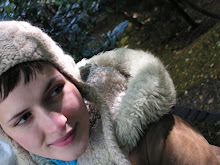Dorothea Lange's photography currently on display in BYU's Museum of Art exhibition, "3 Mormon Towns" will not leave my mind although I first saw it first over two months ago. It was shot in 1953 in the towns of Gunlock, St. George, and Toquerville, Utah. She and Ansel Adams set out to create a photo essay to be published in Life Magazine (although they weren't on assignment.) Lange never informed her photographic subjects of the end goal of the photos, and they were subsequently shocked when it was published. Ansel Adams felt she'd betrayed and disrespected them; neither were satisfied with the end result.
Although commentary on this exhibition includes thoughts on a culture defined by hard work, religion, and small numbers, there are also statements about its documentation of post-war industrialization as the highways gradually encroached on these settlements.
Here are some images from the exhibit:













Lange's skillful command of composition and light powerfully invites you in, but collectively, the exhibition initially left me feeling a little like a stranger stooping to peer through a peephole onto a portion of my own history. Although I don't descend directly from any one of these communities, my own grandparents lived in a nearby and equally rural Escalante, Utah sometime not long after these photographs were taken.
I remembered a quote I'd seen on
Luke's blog over 6 months ago:
"If you’re fifteen or so, today, I suspect that you inhabit a sort of endless digital Now, a state of atemporality enabled by our increasingly efficient communal prosthetic memory. I also suspect that you don’t know it, because, as anthropologists tell us, one cannot know one’s own culture."
BEA talk, William Gibson. 2010.
Fascinating as this quote is, it wasn't the concept of the "digital Now", but the simple reminder that "one cannot know one's own culture" that resonated with me in relation to this exhibit. If I'd been viewing images of 1950's Mormon settlements photographed by Mormon photographers, it wouldn't have provided the same experience. I imagine I would've glossed over them with perhaps a few canned thoughts about their impressive work ethic and the ease of technology we enjoy today. I love that this exhibit provides Mormons the opportunity to gaze upon a piece of their own culture through the lens of a foreigner. It points at their startling strength of conviction through their conscious isolation and rugged lifestyle. It demonstrates their ignorance of cultures outside their own as well as their will to preserve that tiny, hallowed sphere in the face of industrialized growth. These are people living on the edge of the civilization because their religious leader instructed them to do so. I think these are all valuable points to consider.
But even still, and despite the accusatory tone Lange may have felt the very moment her shutter snapped open, there is an overwhelming humanity in the people that carries a familiar sense of comfort. Her skill in capturing portraits astounds me. And admittedly, upon examining the human appeal of these images, I wonder if my insider bias as a Mormon blocks that valuable outsider's view. I know the structure of these faces and bodies. (And maybe it's because Utah Mormons are often of scandinavian descent.) They could just as well be ward members I knew growing up. They remind me of the woman my mother visited for years, who lived in the farmhouse just down our road and lived to be 102. They remind me of the elders in the ward who raised horses for a living and rode them with their kids past our house. They remind me of collecting eggs in the cousin's goat shed next door, climbing trees in bare feet, jumping ditches, and how my mom can't stop canning chicken. They make me feel like a simultaneous stranger and friend, and cause me to wonder what part I have yet to carve out in this peculiar, enduring legacy.
















